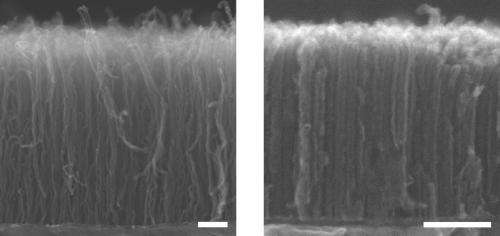Densest array of carbon nanotubes grown to date

Carbon nanotubes' outstanding mechanical, electrical and thermal properties make them an alluring material to electronics manufacturers. However, until recently scientists believed that growing the high density of tiny graphene cylinders needed for many microelectronics applications would be difficult.
Now a team from Cambridge University in England has devised a simple technique to increase the density of nanotube forests grown on conductive supports about five times over previous methods. The high density nanotubes might one day replace some metal electronic components, leading to faster devices. The researchers report their finding in the journal Applied Physics Letters, which is produced by AIP Publishing.
"The high density aspect is often overlooked in many carbon nanotube growth processes, and is an unusual feature of our approach," says John Robertson, a professor in the electronic devices and materials group in the department of engineering at Cambridge. High-density forests are necessary for certain applications of carbon nanotubes, like electronic interconnects and thermal interface materials, he says.
Robertson and his colleagues grew carbon nanotubes on a conductive copper surface that was coated with co-catalysts cobalt and molybdenum. In a novel approach, the researchers grew at lower temperature than is typical which is applicable in the semiconductor industry. When the interaction of metals was analyzed by X-ray photoelectron spectroscopy, it revealed the creation of a more supportive substrate for the forests to root in. The subsequent nanotube growth exhibited the highest mass density reported so far.
"In microelectronics, this approach to growing high-density carbon nanotube forests on conductors can potentially replace and outperform the current copper-based interconnects in a future generation of devices," says Cambridge researcher Hisashi Sugime. In the future, more robust carbon nanotube forests may also help improve thermal interface materials, battery electrodes, and supercapacitors.
More information: The article, "Low temperature growth of ultra-high mass density carbon nanotube forests on conductive supports" by Hisashi Sugime, Santiago Esconjauregui, Junwei Yang, Lorenzo D'arsié, Rachel A. Oliver, Sunil Bhardwaj, Cinzia Cepek and John Robertson appears in the journal Applied Physics Letters: dx.doi.org/10.1063/1.4818619
Journal information: Applied Physics Letters
Provided by American Institute of Physics





















